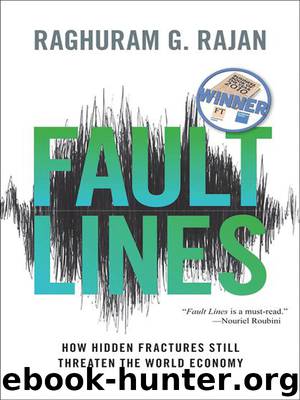Fault Lines by Raghuram G. Rajan

Author:Raghuram G. Rajan
Language: eng
Format: epub
Publisher: Princeton University Press
CHAPTER SEVEN
Betting the Bank
ROUGHLY 60 PERCENT of all asset-backed securities were rated AAA during the lending boom, whereas typically less than 1 percent of all corporate bonds are rated AAA. How could this be, especially when the underlying assets against which the securities were issued were subprime mortgage-backed securities? Was this a sham perpetrated by the rating agencies?
Theory suggests it did not have to be a sham. In certain circumstances, a significant percentage of the securities issued against a package of low-quality loans can be highly rated.1 An example and some simple probability analysis can make the point. Suppose two mortgages, each with a face value of $1 and a 10 percent chance of total default, are packaged together. Suppose further that the investment bank structuring the deal issues two securities against the package— a junior security with face value of $1 that bears the brunt of losses until they exceed $1, and a senior security that bears losses after that.
The senior security suffers losses only if both mortgages default. If mortgage defaults occur independently (that is, they are uncorrelated), then the senior security defaults only 1 percent of the time. This is the magic of combining diversification with tranching the liabilities—that is, creating securities of different seniority. Put a sufficient number of subprime mortgages together from different parts of the country and from different originators, issue different tranches of securities against them, and it is indeed possible to convert a substantial quantity of the subprime frogs into AAA-rated princes, provided the correlation between mortgage defaults is low.
In normal times, the correlation between residential mortgage defaults is low, because people default only because of personal circumstances such as ill health or because they lose their jobs (for cause, rather than as part of a general layoff). No one really knew what that correlation would be in bad times, when many people might lose jobs because of the poor economy and house prices might fall across the country, making refinancing hard. If the correlation was still low, then the ratings were appropriate. If the correlation was high, then all bets were off— if, for example, the correlation was 1, then the senior securities would default as often as the junior securities, that is 10 percent of the time.
The AAA-rated tranches of mortgage-backed securities looked very attractive because they offered a higher return than similarly rated corporate securities. But some should have paid a far higher return because they were in fact very risky. Default correlations were much higher than the rating agencies or investors anticipated. First, the quality of the originated mortgages was low, and many borrowers relied on refinancing as house prices rose to make their payments, so a fall in house prices and the drying up of refinancing almost ensured default for many. Second, far too many packages were poorly diversified across areas: too many mortgages came from the same suspect, aggressive broker from the same subdivision in California.
Indeed, the fact that so many banks were exposed to the
Download
This site does not store any files on its server. We only index and link to content provided by other sites. Please contact the content providers to delete copyright contents if any and email us, we'll remove relevant links or contents immediately.
The Secret History by Donna Tartt(18840)
The Social Justice Warrior Handbook by Lisa De Pasquale(12141)
Thirteen Reasons Why by Jay Asher(8792)
This Is How You Lose Her by Junot Diaz(6782)
Weapons of Math Destruction by Cathy O'Neil(6142)
Zero to One by Peter Thiel(5684)
Beartown by Fredrik Backman(5594)
The Myth of the Strong Leader by Archie Brown(5423)
The Fire Next Time by James Baldwin(5247)
How Democracies Die by Steven Levitsky & Daniel Ziblatt(5127)
Promise Me, Dad by Joe Biden(5087)
Stone's Rules by Roger Stone(5026)
A Higher Loyalty: Truth, Lies, and Leadership by James Comey(4842)
100 Deadly Skills by Clint Emerson(4840)
Rise and Kill First by Ronen Bergman(4701)
Secrecy World by Jake Bernstein(4643)
The David Icke Guide to the Global Conspiracy (and how to end it) by David Icke(4624)
The Farm by Tom Rob Smith(4434)
The Doomsday Machine by Daniel Ellsberg(4415)
